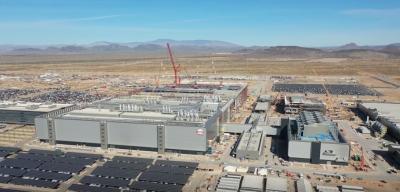One of the largest construction projects in St. Louis history is mired in controversy, missed deadlines and cost overruns, but through it all, construction continues on MetroLink’s Cross County Extension, an eight-mile line that will take the light rail system west into St. Louis County from Forest Park, the city’s “Central Park.” The latest projected completion date for the job is October 2006.
Metro (formerly Bi-State Development Agency), the agency that runs both the light rail and bus system in St. Louis, is using a quarter-cent sales tax levied in St. Louis and St. Louis County in 1994, as well as the retirement of 30-year bonds, to pay for construction of the extension.
The MetroLink system currently spans 38 miles from Shiloh and Scott Air Force Base in Illinois to Lambert-St. Louis International Airport. Metro said it will add 22 new light rail vehicles to carry the additional 18,000 passengers it expects the new line will bring.
Metro Magazine, in its list of rail projects currently under construction in the United States, ranked the MetroLink Cross County Extension as No. 22 by cost.
The project is so large Metro broke construction into five segments and awarded separate contracts for each:
• Segment 1 from the existing Forest Park-DeBaliviere station west to Kingsland. Tarlton Corp is the contractor.
• Segment 2 from Kingsland to Ritz Carlton Drive in suburban Clayton. McCarthy Building Companies Inc. is the contractor.
• Segment 3 from Ritz Carleton Drive to Enterprise Leasing. Fred Weber Inc. is the contractor.
• Segment 4 from Enterprise to Sunnen Drive in Maplewood. Fred Weber Inc. is the contractor.
• Segment 5 from Sunnen Drive to Lansdowne in Shrewsbury. KCI Construction is the contractor.
Metro also awarded a contract to L. K. Comstock and Co. Inc. to install rails, signals, communication and electrical work, as well as several other contracts to other companies for sewer pipe replacement, fare collection equipment and station finishes.
Each segment of the project has its own distinctive characteristics and challenges, said Cathie Farroll, a Metro spokesperson.
Segment 1 includes the junction of the new line and the existing line. Construction crews had to work near the live tracks of the original line, which trains continued to run on.
Segment 2 features the project’s longest tunnel, a 5,500-ft. stretch from east of Big Bend to behind the Ritz Carleton in Clayton.
Segment 3 runs through a busy commercial area as well as a residential district. This segment also includes several ramps and other road improvements funded by St. Louis County and Clayton.
Segment 4 has a large number of utility conflicts and a tunnel under Interstate 64.
Segment 5 has a vast majority of the system running on bridges or on high retained fill.
In addition, construction teams have faced major reconstruction of the Forest Park-DeBaliviere station, construction of nine new stations, the building of four tunnels and more than 900 utilities conflicts, far more than original projections.
The extension also crosses three major thoroughfares, including Interstate 44 and Interstate 170. Most of the segments had little to no staging area.
The Delays
The public has expressed frustration with the multiple delays in the project, which was originally to be completed in 2005, although Metro has said that date was a design deadline, not a project completion deadline.
Some are unhappy that the extension isn’t yet an option to deal with the country’s spiraling gas prices while others are frustrated at the closing of some of the area’s major streets during construction.
For example, Forest Park Parkway, one of the region’s major east-west thoroughfares, has been closed in segments since early summer of 2003. Metro has not yet set a firm date for reopening it, but expects to put the road back in service early next year.
Skinker Boulevard, which Metro planned to close for one week, is likely to stay shut for at least two weeks because of an unanticipated replacement of a portion of SBC’s underground infrastructure. Metro projected the work would be completed and the street reopened by the end of June.
A History
The project’s inception goes back to early 1990s when directors of the East-West Gateway Coordinating Council, now the East-West Gateway Council of Governments, approved a set of potential extensions for the original MetroLink. In June 1999, the council approved the alignment for the Cross County MetroLink Extension project and turned it over to the Bi-State Development Agency for construction.
In April 2000, Metro selected the joint venture known as the Cross County Collaborative (CCC) for program management, design, construction management and start-up services under a $40.7 million fixed price contract.
Controversy has swirled around the project from the start. By 2004, when Metro let construction contracts, the completion date slipped into 2006.
The Cross County Extension’s latest price tag, announced in March, is $646 to $676 million, significantly more than its prior $550 million price tag and far beyond what many claim was the original cost of $404 million.
Metro President and CEO Larry Salci disputes that the $404 million figure bandied about in the press was for the completed project. He said it was East-West Gateway Coordinating Council’s cost figure for a conceptual plan at the 10 percent design level based on constant 1999 dollars.
“It was the conceptual design,” Salci said. “If you took that conceptual design to Wall Street and said, ’Finance this,’ they’d throw you out of the building. It’s laughable. It doesn’t have sufficient detail –– it’s conceptual. I want to underline that.”
By increasing the $404 million to the inflated dollars needed to build the system, the real initial cost estimate was $477 million, he said.
“It’s going to take you five years to build it,” he said. “You don’t put a number [like that] out there, which the community did, but it was not understood by the community that these were not inflated dollars.”
Although the $404 million conceptual figure came from East-West Gateway, in 2000 CCC reviewed the approved plans and recommended making 20 major changes, Salci said.
Metro adopted seven of the changes, mostly ones that dealt with safety, operation and significant changes to the alignment.
One of the most costly was the change from East-West Gateway’s plan to have the system running in the middle of Forest Park Parkway from DeBaliviere through University City into Clayton.
Instead, Metro opted to run the line on the south side of Forest Park Parkway along an old streetcar line.
“We took it off the Parkway,” Salci said. “There was a cost associated with that.”
That, and several other “significant changes,” led CCC to recommend a final budget of $550 million, Salci said.
Stations at Skinker and Big Bend would be below ground and the system was going to run subsurface from Big Bend into Clayton. And, officials debated the location of the Clayton station –– Central Avenue at the parkway versus Hanley Road at the parkway –– before Metro chose the Central Avenue location.
“Those were some of the things that bounced around here for about a year and a half, and they were largely driven by the local communities –– University City, Clayton, etc.,” said Salci. “The final budget –– and the only real budget of the project –– was at 30 percent of design level. Now you go to 30 percent of design. At 30 percent of design, the project is financeable.”
Salci added that when he was recruited for the job he was told the budget had been approved at 30 percent of design, and Metro was looking for financing.
“However, when I got here in February [2002], I found I was greeted with a room of 50 people from the various communities all demanding more changes,” he said. “And I said, ’What’s going on here?’ At 30 percent of design, we’re done with the alignment and its profile. There are no more changes.’ And yet Metro at the time was still entertaining the community’s changes.”
During the first three months after he came to St. Louis, Salci said he met with the leaders of each municipality involved in the project.
“I said, ’Okay, you got one more bite at the apple. You shouldn’t have, but you do. We’re going to put this thing to bed because we have to lock the design or the cost is never going to get finalized,’” he said.
The board approved final changes in May 2002, and Metro told CCC the plan was locked, and no more changes could be made. At that point, the company was supposed to finish the rest of the design.
“They were supposed to be at 100 percent of design by May ’02 but they were only at 30 or 40, a lot of that legitimately because some of the design work was up in the air,” Salci said.
CCC met Metro’s new deadline of December 2002.
“They came to us in December 2002 and said ’the design is 100 percent complete. We’re now ready to take the design documents and put them in bid documents so the contractors can bid,’” said Salci.
“What we know now and they knew then was the design wasn’t complete. We went out on the street with bid documents that were incomplete, which caused our contractors much heartburn and a lot more money, which we had to pay for,” he added.
Construction began in 2003 but Salci ended up firing CCC last year. At that time, CCC’s schedule for completion was January 2007.
“They were already two years behind schedule,” Salci said.
According to Salci, CCC’s $41 million contract was to design, handle the construction management and deliver a system by a specific deadline.
“They agreed, when they signed their contract with us, to have that system open by May of 05,” he said.
Besides the delay, the St. Louis Post-Dispatch recently reported that taxpayers might be stuck paying millions in cost overruns because of an unusual clause in the contract Metro signed with CCC. That clause limits the CCC’s liability to $8 million.
Salci came out of retirement to run Metro. The St. Louis Area Concerned Taxpayers, a group representing mostly North City and North County bus riders, has been at odds with Metro and Salci. A spokesman for the group has called for Salci to resign, blaming agency mismanagement for the extension cost overruns.
The St. Louis chapter of ACORN (Association of Community Organizations for Reform Now) and The St. Louis Area Concerned Taxpayers have criticized the agency and oppose fare increases that Metro’s board adopted on June 24. Some riders have accused Metro of increasing bus fares to help cover the cost of building the Cross County Extension.
Not that Salci doesn’t understand their reasoning.
“It’s very hard for the community –– the transit-riding public in particular and particularly those who ride buses –– to understand why the community would undertake building a 10-mile extension of MetroLink when it can’t support the existing bus and rail system it has,” he said.
According to Salci, when he arrived in St. Louis in 2002, he was greeted with “a boardroom of screaming, howling, angry bus riders [saying], ’Why are you cutting my bus service? Oh, you’re cutting it to pay for MetroLink.’
“Well, it’s pretty hard to look these people in the face and say, ’You’re wrong’ because you know what? They were right. The elected officials of this community don’t like me saying that but I’m going to continue saying it because the transit policy of this town is upside down, and it needs to be straightened out,” he added.
The only way to do that in the short term, according to Salci, is to get the additional sales tax the state has authorized for MetroLink, as this year the legislature increased the ceiling on the tax to one cent from a half cent.
“But that can’t happen until 2007 because of the local election situation,” he said.
According to Salci, some of the costs could be recovered in the lawsuit Metro has pending against CCC, but that case won’t be heard until March of 2006.
Salci declined to discuss specifics of the situation because of the pending lawsuits, but he did say Metro gave CCC more than a year to “cure the defaults,” but it didn’t.
Errors and omissions in drawings “that should have been done that weren’t caused our field contractors to incur all kinds of additional cost which we had to pay for,” he said. “That’s what the lawsuit’s about,” he added.
“On top of that, we found instances where they billed us for things they didn’t do, and that’s fraud,” Salci said.
On June 24, Metro commissioners also authorized in principle the selling of $150 million of bonds to cover the overrun. The agency plans to sell the bonds in July.
“We’re looking at a five-year horizon because we’re assuming the lawsuit, even if we win, will be appealed, and we’re looking at a three-year legal window,” Salci said. “Whatever we get as the lawsuit settlement will basically be used as a first pledge to pay off the proceeds of the bonds.”
An employee of one contracting company complained that his company could not build without design plans and the company is made to look like it doesn’t know what it is doing.
“Understand this,” Salci said. “The contractors aren’t the problem. The problem is the engineers –– consulting engineers. People get the contractor and consulting engineers confused.”
Salci said he hired 30 engineers and brought in two additional engineering companies to allow Metro to manage the project directly after he fired CCC.
“We’ve pulled the schedule back to September-October of ’06,” he said. “We pulled the schedule back ourselves four months by renegotiating and basically doing better planning and getting accelerated work of our field contractors. We had a disaster on our hands with [CCC], and that’s why we fired them.” CEG
Today's top stories















